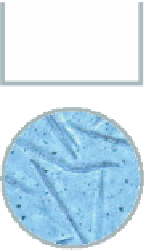Geoscience Reference
In-Depth Information
Bricks, terracotta,
and other ceramics
9
Romans, and the Venetians enabled its use as flat sheets
for glazing. Today architectural glass is used for a range
of glazing, curtain walling, and tiling applications.
The techniques discussed in the following section can
be applied to a much wider range of ceramic materials
including pottery, porcelain, and refractories. The principal
uses of petrographic examination for investigations of
bricks, terracotta, and other ceramics are:
• Identifying the type of material.
• Identifying the ingredients used.
• Providing clues to the details of the manufacturing
process.
• Screening the product for inherent defects.
• Identifying the causes of failures.
• Diagnosing decay mechanisms and assessing the
level of deterioration.
The term 'ceramic' is derived from the Greek keramos,
meaning 'potter's clay'. Gradually this was extended to
include all products made from fired clay and a variety
of other nonmetallic inorganic solids. The main types of
ceramics used for construction are clay bricks, terracotta,
faience, ceramic tiles, and glass.
The earliest bricks used for building were sun-dried
mud bricks dating back at least 10,000 years. For
stronger brick units, clayey material is fired in a kiln to
vitrify, producing a burnt brick. These more resilient fired
clay bricks were developed at about 3500
BC
and by
1200
BC
fired bricks were being used in durable masonry
construction throughout Europe, Asia, and North Africa
(Campbell & Pryce, 2003). Clay brick remains an
important building material for masonry structures.
Terracotta and faience (glazed terracotta) are moulded
clay products comprising hollow blocks, tiles, and
sculptural pieces. They are carefully made from specially
prepared fine clay mixtures and are usually very well
vitrified. They have a hardness and sharpness of detail
not normally obtained from brick. They were most widely
used in the British and United States building industries
in the period 1840-1910
AD
(the so called 'Terracotta
Revival' period).
The use of decorative ceramic tiles for covering walls
and floors dates back to ancient Babylon and Egypt and
they were later used to great effect by the Persian and
Roman civilizations. These traditionally comprised various
sizes including small mosaic tiles and were commonly
made of a clay-based body, to which a silicate glaze was
applied. The familiar large square or rectangular tile
appeared around 1600
AD
as the characteristic blue Delft
tile. Tile-making machines began to appear in the early
19th century and today the process is highly automated to
meet the demand for large-scale production.
Making glass by heating silica goes back 4000 years
to the production of beads and small vessels in Middle
Eastern civilisations. Advancements in glass production
technology by, amongst others, the Egyptians, the
COMPLEMENTARY TECHNIQUES
In the absence of a specific standard procedure for
ceramics, petrographic examination procedures could be
adapted from the guidance in EN 12407 (British Standards
Institution, 2007). An initial visual and low-power
microscopical examination is conducted to determine the
number of material types, dimensions, manufacturing
marks, colour, and the relative hardness, bond strength,
and coherence of the material. For examination of smooth
glazed surfaces or glass surfaces the use of oblique lighting
can be used to pick out surface defects. High-power
examination of thin section specimens can then be used to
determine the type of ceramic, the nature of the vitrified
matrix, the identity of any additives or impurities, and to
screen the material for evidence of distress or
deterioration. High-power examination of polished
specimens is also suitable for investigating ceramics.
Polished specimens may be etched to improve the
resolution of grain boundaries and other features. A
detailed account of the techniques involved in polished
specimen preparation, examination, and interpretation for
ceramics is provided in Chinn (2003).







